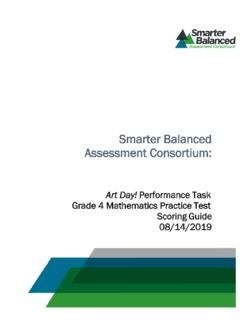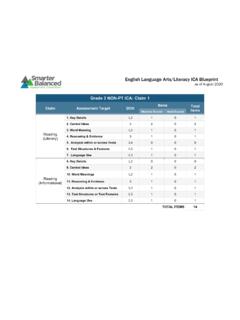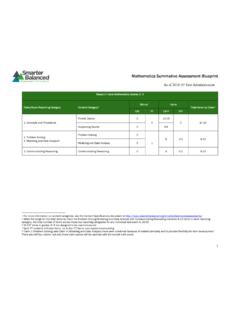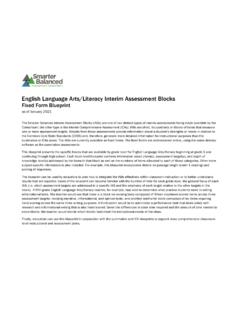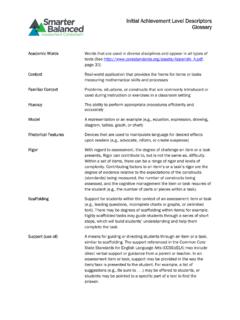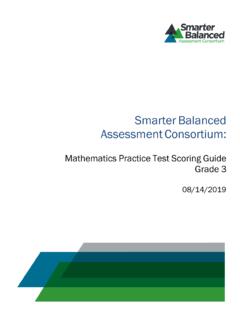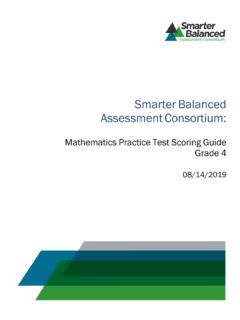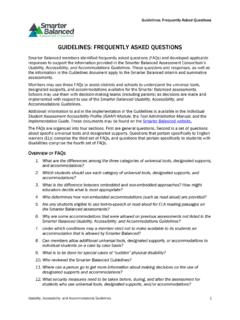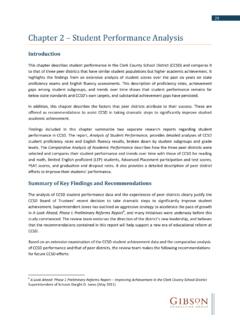Transcription of Usability, Accessibility, and Accommodations Guidelines
1 Smarter Balanced Assessment Consortium: Usability, Accessibility, and Accommodations Guidelines Prepared with the assistance of the National Center on Educational Outcomes June 30, 2020 Usability, Accessibility, and Accommodations Guidelines Usability, Accessibility, and Accommodations Guidelines ii TABLE OF CONTENTS TABLE OF CONTENTS .. ii Introduction .. 4 Intended Audience and Recommended Use .. 5 Smarter Balanced Assessment Design .. 5 Recognizing Access Needs in All Students .. 5 Structure of This Document .. 8 Section I: Smarter Balanced Universal Tools .. 9 What Are Universal Tools? .. 9 Embedded Universal Tools .. 9 Non-embedded Universal Tools .. 11 Section II: Smarter Balanced Designated Supports .. 13 What Are Designated Supports? .. 13 Who Makes Decisions About Designated Supports? .. 13 Embedded Designated Supports .. 13 Non-embedded Designated Supports .. 17 Section III: Smarter Balanced Accommodations .. 22 What Are Accommodations ?
2 22 Who Makes Decisions About Accommodations ? .. 22 Embedded Accommodations .. 23 Non-embedded Accommodations .. 25 Resources .. 29 Appendix A: Summary of Smarter Balanced Universal Tools, Designated Supports, and Accommodations .. 30 Appendix B: Research-based Lessons Learned about Universal Design, Accessibility Tools, and Accommodations .. 32 Who might benefit from accessibility features identified by AA-MAS research? .. 32 What changes can be made to test items and tests that do not change the construct being assessed? .. 32 What can test developers do to build on the lessons learned from AA-MAS research and implementation? .. 33 Appendix C: Frequently Asked Questions .. 35 Overview of FAQs .. 35 General FAQs .. 37 Universal Tools and Designated Supports FAQs (Available to All Students) .. 44 Usability, Accessibility, and Accommodations Guidelines Usability, Accessibility, and Accommodations Guidelines iii FAQs Pertaining to English Learners (ELs).
3 45 FAQs Pertaining to Students with Disabilities .. 47 Appendix D: Read Aloud Guidelines .. 50 Images/Graphics/Diagrams/Tables .. 56 From top to bottom .. 56 From left to right .. 57 Clockwise (Start wherever makes sense.) .. 57 Tables .. 58 Appendix E: Scribing Protocol for Smarter Balanced Assessments .. 61 Considerations for students also using ASL or other sign system .. 64 Appendix F: Revision Log .. 66 Usability, Accessibility, and Accommodations Guidelines Usability, Accessibility, and Accommodations Guidelines 4 INTRODUCTION The Smarter Balanced Assessment Consortium (Smarter Balanced) strives to provide every student with a positive and productive assessment experience, generating results that are a fair and accurate estimate of each student s achievement. Further, Smarter Balanced is building on a framework of accessibility for all students, including English Learners (ELs), students with disabilities, and ELs with disabilities, but not limited to those groups.
4 In the process of developing its next-generation assessments to measure students knowledge and skills as they progress toward college and career readiness, Smarter Balanced recognized that the validity of assessment results depends on each and every student having appropriate universal tools, designated supports, and Accommodations when needed based on the constructs being measured by the assessment. This document was developed for the Smarter Balanced members to guide the selection and administration of universal tools, designated supports, and Accommodations . The Smarter Balanced assessment is based on the Common Core State Standards (CCSS). Thus, the universal tools, designated supports, and Accommodations that are appropriate for the Smarter Balanced assessment may be different from those that members allowed in the past. For the secure summative assessments, a member can only make available to students the universal tools, designated supports, and Accommodations that are included in the Smarter Balanced Usability, Accessibility, and Accommodations Guidelines (UAAG).
5 A member may elect not to make available to its students any universal tool, designated support, or accommodation that is otherwise included in the Guidelines when the implementation or use of the universal tool, designated support, or accommodation is in conflict with a member s law, regulation, or policy. These Guidelines describe the Smarter Balanced universal tools, designated supports, and Accommodations available for the Smarter Balanced assessments at this time (see Appendix A). The specific universal tools, designated supports, and Accommodations approved by Smarter Balanced may change in the future if additional tools, supports, or Accommodations are identified for the assessments based on member experience and research findings. The Consortium has established a standing committee, including representatives from Governing members that review suggested additional universal tools, designated supports, and Accommodations to determine whether changes are warranted.
6 Proposed changes to the list of universal tools, designated supports, and Accommodations are brought to Governing members for review, input, and vote for approval. Furthermore, members may issue temporary approvals ( , one summative assessment administration) for individual unique student Accommodations or designated supports. K-12 leads will evaluate formal requests for unique Accommodations /designated supports and determine whether or not the request poses a threat to the measurement of the construct. Upon issuing a temporary approval, the member will send documentation of the approval to the Consortium. The Consortium will consider all member-approved temporary Accommodations /designated supports as part of the annual Consortium UAAG review process. If the Consortium determines it requires additional time to study the issue before the Consortium can engage in a vote, a member may notify the Consortium that the member intends to issue temporary approvals for the same accommodation /designated support during the next summative assessment administration.
7 Members should include in their notification to the Consortium the intended use of the temporary accommodation /support and the rationale for issuing temporary authorizations for the next summative assessment administration. The Consortium will provide to members a list of the temporary Accommodations /designated supports issued by members that are not Consortium-approved Accommodations /designated supports and cannot be authorized for the next summative assessment administration. Usability, Accessibility, and Accommodations Guidelines Usability, Accessibility, and Accommodations Guidelines 5 INTENDED AUDIENCE AND RECOMMENDED USE The Smarter Balanced Assessment Consortium s Usability, Accessibility, and Accommodations Guidelines are intended for district- and school-level personnel and decision-making teams, particularly Individualized Education Program (IEP) teams, as they prepare for and implement the Smarter Balanced assessment. The Guidelines provide information for classroom teachers, English development educators, special education teachers, and related services personnel to use in selecting and administering universal tools, designated supports, and Accommodations for those students who need them.
8 The Guidelines are also intended for assessment staff and administrators who oversee the decisions that are made in instruction and assessment. The Smarter Balanced Guidelines apply to all students. They emphasize an individualized approach to the implementation of assessment practices for those students who have diverse needs and participate in large-scale content assessments. This document focuses on universal tools, designated supports, and Accommodations for the Smarter Balanced content assessments of English language arts (ELA)/literacy and mathematics (math). At the same time, it supports important instructional decisions about accessibility and Accommodations for students who participate in the Smarter Balanced assessments. It recognizes the critical connection between accessibility and Accommodations in instruction and accessibility and Accommodations during assessment. The Guidelines also are supported by the Smarter Balanced Test Administration Manual (TAM).
9 SMARTER BALANCED ASSESSMENT DESIGN The Smarter Balanced Assessment Consortium has developed a system of valid, reliable, and fair next-generation assessments aligned to the CCSS in English language arts/literacy and mathematics for grades 3-8 and High School (HS). The system includes summative assessments for accountability purposes, optional interim assessments for local use, and formative tools and processes for instructional use. Computer adaptive testing technologies are used for the summative and interim assessments to provide meaningful feedback and actionable data that teachers and other stakeholders can use to help students succeed. For more information, visit RECOGNIZING ACCESS NEEDS IN ALL STUDENTS All students (including students with disabilities, English learners (ELs), and ELs with disabilities) are to be held to the same expectations for participation and performance on Smarter Balanced assessments. Specifically, all students enrolled in grades 3-8 and HS are required to participate in the Smarter Balanced mathematics assessment except: Students with the most significant cognitive disabilities who meet the criteria for the mathematics alternate assessment based on alternate achievement standards (approximately 1% or fewer of the student population).
10 All students enrolled in grades 3-8 and HS are required to participate in the Smarter Balanced English language arts/literacy assessment except: Students with the most significant cognitive disabilities who meet the criteria for the English language arts/literacy alternate assessment based on alternate achievement standards (approximately 1% or fewer of the student population). ELs who are enrolled for the first year in a school. These students instead participate in their required English language proficiency assessment. Usability, Accessibility, and Accommodations Guidelines Usability, Accessibility, and Accommodations Guidelines 6 Federal laws governing student participation in assessments must meet the requirements of the Every Student Succeeds Act (ESSA) of 2016, the Individuals with Disabilities Education Improvement Act of 2004 (IDEA), and Section 504 of the Rehabilitation Act of 1973 (reauthorized in 2008). Recognizing the diverse characteristics and needs of students who participate in the Smarter Balanced assessments, the Smarter Balanced members worked together through the Smarter Balanced Test Administration and Student Access Work Group to develop an Accessibility and Accommodations framework that guided the Consortium as it worked to reach agreement on the specific tools, supports, and Accommodations available for the assessment.
